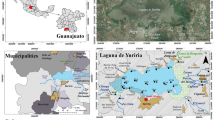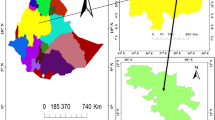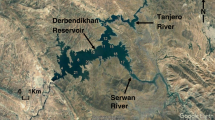Abstract
The Sejnane reservoir in northeast Tunisia provides drinking and irrigation water. Long-term water quality monitoring data including precipitation, evaporation, temperature, pH, conductivity, dissolved oxygen, turbidity, total suspended solids, major anions and cations, fluoride, BOD5, NO3 −, NO2 −, NH4 +, P tot, fecal coliform bacteria, boron and heavy metals (Fe, Zn, Cu, Ni, Pb, Cr and Cd) are reported. The appropriateness for irrigation was estimated by the SAR and Na percentage and the water quality assessed using the Canadian Water Quality Index as good to excellent, which confirmed its suitability for drinking, aquatic life and irrigation purposes.
Résumé
Le barrage Sejnane, situé au nord est de la Tunisie, a pour objectif de contribuer à la satisfaction des besoins en eau potable et l’irrigation des terres agricoles. L’article présente un suivi à long terme des paramètres de la qualité des eaux: précipitation, évaporation, température, pH, conductivité, oxygène dissous, turbidité, matières en suspension, Na+, K+, Ca2 +, Mg2+, Cl−, F−, SO =4 , HCO3 −, BOD5, NO3 −, NO2 −, NH4 +, P tot, coliformes fécaux, bore et métaux lourds (Fe, Zn, Cu, Ni, Pb, Cr et Cd). La compilation de ces résultats a été réalisée avec une technique d’analyse multivariable pour la réduction des données. La convenance pour l’irrigation a été évaluée par les indices SAR et le pourcentage de sodium. Cette étude démontre la conformité des eaux aux règles de potabilité, de vie aquatique et d’irrigation. La qualité de l’eau a été évaluée via l’Indice canadien de qualité d’eau (WQI) et qualifiée de bonne à excellente.











Similar content being viewed by others
References
Addinsoft (1995–2002) XLStat-pro. 5.1 Version 4, Paris, France
Antweiler RC, Goolsby DA, Taylor HE (1995) Nutrients in the Mississippi River. US Geological Survey Circular 1133. USGS, Denver
APHA (1975) Standard methods for the examination of water and waste water, 14th edn. American Public Health Association, Washington DC
APHA (1995) Standard methods for the examination of water and wastewater, 19th edn. American Public Health Association/American Water Works Association/Water Environment Federation, Washington DC
Back W (1961) Techniques for mapping of hydrochemical facies. USGS Prof. Pap., vol 424D, pp 380–382
Back W, Hanshaw BB (1965) Chemical geohydrology. Adv Hydrosci 2:49–109
Ben Othmen D (2003) Etude de la qualité des eaux du barrage Sidi Salem. Thesis, Fac. Sci., Tunis, p 150
Bouden S (1995) Etude de la qualité des eaux du barrage Sidi Saad. Thesis, Fac. Sci., Tunis, p 92
Brooks KN, Ffolliott PF, Gregersen HM, DeBano LF (1997) Hydrology and the management of watersheds, 2nd edn. Iowa State University Press, Ames, p 502
Canadian Council of Ministers of the Environment (CCME) (1999) Water Quality Index 1.0, Technical report, p 5
Canadian Council of Ministers of the Environment (CCME) (2001a) Canadian water quality index 1.0—technical report. Canadian water quality guidelines for the protection of aquatic life. Canadian environmental quality guidelines, p 13
Canadian Council of Ministers of the Environment (CCME) (2001b) Canadian Water Quality Index 1.0—user’s manual. Canadian water quality guidelines for the protection of aquatic life. Canadian environmental quality guidelines, p 5
Castany G (1953) Le Tyrrhénien de la région de Bizerte. Bull Soc Sci Nat t VI:1952–1953
Chatfield C, Collin AJ (1980) Introduction to multivariate analysis. Chapman & Hall/Methuen, New York. ISBN 0-412-16030-7
Cheverry C (1972) Exemple d’application des travaux de l’US Salinity Laboratory (1963–1968) sur l’alcalinisation des sols soumis à l’action d’eaux carbonatées, Cah., ORSTOM., Serv., Pédol., 10, no. 2, pp 193–203
Commission of European Communities (CEC) (1978) Council Directive of 18 July 1978 on the quality of fresh waters needing protection or improvement in order to support fish life, (78/659/EEC). Official J L/222:1–10
Crampon N (1971) Etude géologique de la bordure des Mogods, du pays de Bizerte et du Nords des Hedil (Tunisie septentrionale). Thesis, Sci. Natur., Nancy I, tome 1, Stratigraphie, pp 1–228
Davis JC (1986) Statistics and data analysis in Geology, 3rd edn, p 638
Dehayer R, Diatloff N, Gordon I (1997) Irrigation water quality salinity and soil structure stability, Water facts, ISSN 1327–5364
Food and Agriculture Organization (1994) Water quality for agriculture, 29 Rev. 1, p 174. ISBN 92-5-102263-1
Gaabab F (1997) Etude géochimique des eaux du basin versant du barrage Bir M’cherga. Thesis, Fac. Sci., Tunis, p 135
Hadj Zekri S (2003) Evaluation de la qualité des eaux de deux hydrosystèmes du nord de la Tunisie: les retenues des barrages Joumine et Sejnène. 3rd cycle thesis, National Institute of Agronomy of Tunis (INAT), p 161
Hounslow AW (1995) Water quality data analysis and interpretation. Lewis Publishers, New York, p 397
Piper AM (1944) A graphic procedure in the geochemical interpretation of water analyses. Trans Am Geophys Union 25:914–932
Richards LA (1954) Diagnosis and improvement of saline and alkali soils. Agriculture handbook, vol 60. US Department of Agriculture, Washington DC
Rodier J (1978) L’analyse de l’eau, Eaux naturelles, eaux résiduaires et eau de mer, DUNOD, Ed, Paris
Rouvier H (1977) Géologie de l’extrême Nord tunisien: Tectoniques et paléogéographies superposées à l’extrémité orientale de la Chaîne nord maghrébine. Thesis, Univ. Pierre et Marie Curie, p 427
United States Salinity Laboratory Staff (1954) Diagnosis and improvement of saline and alkali soils, USDA agriculture handbook no. 60, US Gov
Sternick K (1990) La trophie et l’eutrophisation du barrage Sidi Salem. Ann. Lim., Tunis, p 40
Wilcock RJ, McBride GB, Nagels JW, Northcott GL (1995) Water quality in a polluted lowland stream with chronically depressed dissolved oxygen: causes and effects. New Zealand J Mar Freshw Res 29:277–288
Wilcox LV (1948) The quality of water irrigation. US Dept Agric Tech Bull 962:1–40
World Health Organization (WHO) (1996) Chapman D (ed) Water quality assessments—a guide to use of biota, sediments and water in environmental monitoring, 2nd edn. UNESCO/WHO/UNEP. ISBN 0 419 21590 5
World Health Organization (WHO) (2004) Guidelines for drinking-water quality, vol 1, 3rd edn, 540 p. ISBN 92 4 154638 7
Zouabi B (2003) Etude de la qualité des eaux du Barrage Sejnane. Thesis, Fac. Sci., Tunis, p 109
Acknowledgments
The authors would like to thank the staff of technicians (Laboratory of geochemistry—Ben Arous) for their assistance in the acquisition of samples and chemical analysis, Samia ZOUABI and specially Tahar ALOUI for their assistance in the preparation of this manuscript.
Author information
Authors and Affiliations
Corresponding author
Appendix 1
Appendix 1
See Table 5.
Rights and permissions
About this article
Cite this article
Zouabi Aloui, B., Gueddari, M. Long-term water quality monitoring of the Sejnane reservoir in northeast Tunisia. Bull Eng Geol Environ 68, 307–316 (2009). https://doi.org/10.1007/s10064-009-0186-1
Received:
Accepted:
Published:
Issue Date:
DOI: https://doi.org/10.1007/s10064-009-0186-1
Keywords
- Water quality
- Water Quality Index
- Sodium adsorption ratio
- Sodium percent
- Irrigation
- Principal component analysis




